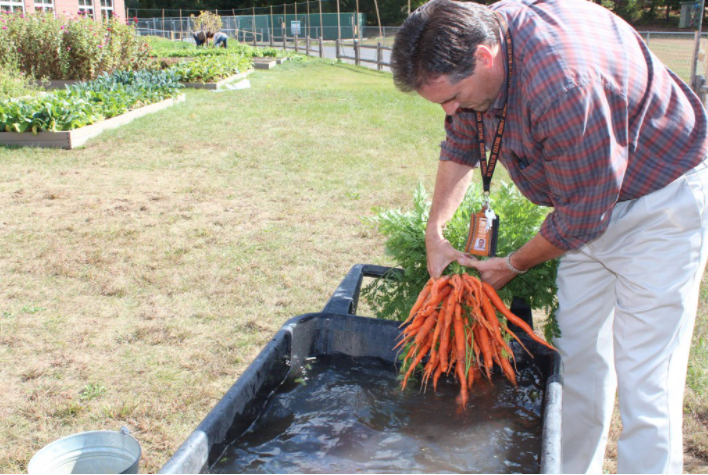One of our Green Team’s initiatives is teaching students about the food we eat — not just its nutritional content, but about the way our food is grown, and how far our food is shipped, and how these elements impact our bodies, our economy and our community.
Students learn that…
- The way food is grown has a huge impact on our environment and health. Many of the grains, fruits and vegetables we eat are grown using herbicides, pesticides and fungicides that are harmful. These chemicals hurt farm workers, harm fish and animals, pollute fresh water supplies and present health issues for consumers. Most of the meat we eat comes from feedlots that rely on steroids and antibiotics to keep animals big and healthy. These chemicals mixed with the huge amounts of waste is a major source of pollution.
- The way our food is shipped impacts us and the environment. Most of the food we eat travels over 1,500 miles from its origin. Food that is shipped long distances requires a large amount of energy to move, which means large amounts of pollution. Food that travels a great distance before it gets to market is harvested before it is ripe, so that it will last during transport. This early picking decreases the vitamin and mineral contents, which also affects the taste in freshness. Buying food from far away also takes your money far away, instead of supporting local producers.
We teach our students about and show them how supporting local, sustainable agriculture will aid in solving many current environmental issues and how to make a difference in their own community. In order to model this important change, each school across the district has an organic school garden. These gardens are designed to grow organic produce that can be used in our school cafeterias.
Organic School Gardens

Each of the schools in the Bethlehem Cental School District has an organic garden, which supplements the food that is prepared and served in our school cafeterias. The students not only see the end result of the garden in their own school lunches but take an active role in planting in the gardens, tending to the gardens and picking produce from the garden. They work with district staff and parents volunteers to work in the gardens throughout the school year and during the summer. You may even periodically see produce from our school gardens at the Delmar Farmer’s Market!
The kitchen gardens in the Bethlehem schools strive to:
- Grow organic produce that is used in the school cafeteria
- Grow crops that can be sold at market, or in school, to raise funding
- Model organic growing methods
- Connect to the larger environmental movement of the district
Some of what our students learn about gardening:
Gardening begins and ends with the soil. Seeds germinate in the soil, or transplants are placed in the soil, with the hopes that they then grow to be healthy plants. The goal of organic gardening is to work with the soil to create the best possible growing conditions for our crops. The motto of the organic gardener is, “Feed the soil, not the plant”. The most important job of an organic gardener is to create and maintain healthy, living soil. The soil, and the organisms that inhabit the soil, actually create a living system. The earthworms, ants, spiders and beetles and other insects are only a tiny portion of the organisms that call the ground their home. Bacteria, fungus and millions of microscopic organisms live in the soil and break up organic matter like leaves and straw. This leaves behind trace elements that plants need to grow. Tending to the soil organisms is actually tending to the plants. Growing organically means that you use, and protect, the systems that nature models for us; without the use of chemical or synthetic fertilizers, fungicides, pesticides or herbicides.
Kitchen Garden Rotation — School Cafeteria
Crops are planted at certain times of the year in order to provide fresh, organic produce in the school cafeteria. There are two main times during the school year that vegetable crops can be harvested; late spring and early fall. Vegetable availability is based on the school calendar and the growing conditions in the northeast. Vegetables can be either started indoors or started from seed. Vegetables started indoors will be available earlier than those started from seed.
SPRING CROP PLANTING SCHEDULE (DIRECT SEED)
Lettuce:
- Planting – 1st week in April
- Harvest – 2nd/3rd week of June
Onion:
- Planting – 1st week in April
- Harvest – 2nd/3rd week of July
Radish:
- Planting – 1st week in April
- Harvest – 1st/2nd week of May
Carrot:
- Planting – 2nd week in April
- Harvest – 1st week of July
Spinach:
- Planting – 1st week in April
- Harvest – 2nd/3rd week of May
Flowers:
- Planting – 3rd week of May
- Harvest – All summer/into fall
SUMMER CROP PLANTING SCHEDULE
Lettuce:
- Planting – Middle of July (then every two weeks)
- Harvest – 1st/2nd week of September
Carrot:
- Planting – 3rd week in July
- Harvest – 1st week of October
Beans:
- Planting – 4th week in July
- Harvest – 2nd/3rd week of September
Radish:
- Planting – 2nd week in August
- Harvest – 2nd/3rd week of September
FALL CROP PLANTING SCHEDULE
Garlic:
- Planting – Middle of October
- Harvest – 2nd/3rd week of July
